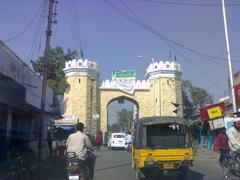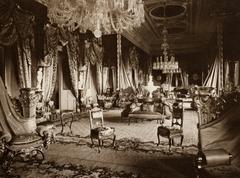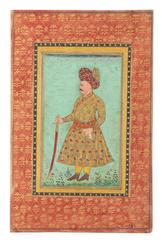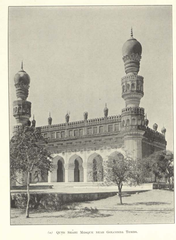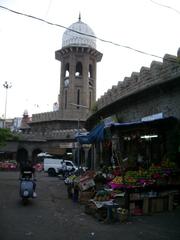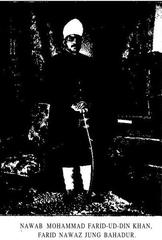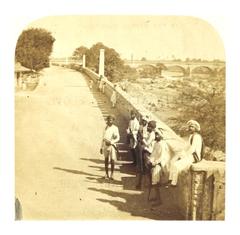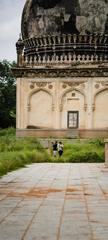
Kulsum Begum Masjid: Visiting Hours, Tickets, and Historical Guide – Hyderabad
Date: 03/07/2025
Introduction
Nestled in the Karwan locality of Hyderabad, the Kulsum Begum Masjid stands as a remarkable emblem of the city’s Islamic heritage and architectural splendor. Commissioned in the 17th century by Kulsum Begum, daughter of Sultan Muhammad Qutb Shah of the Qutb Shahi dynasty, this mosque is a rare and significant example of female patronage in South Asian Islamic architecture. Its construction reflects a period when Hyderabad thrived as a cosmopolitan hub, blending Persian, Turkish, and Deccan influences. Today, the mosque continues to serve as an active place of worship and an important cultural landmark, drawing devotees, history enthusiasts, and tourists alike (Hello Hyderabad, Wikipedia, Roof and Floor).
Table of Contents
- Origins and Patronage
- Architectural Features and Qutb Shahi Influence
- Historical Context and Urban Significance
- Religious and Cultural Legacy
- Visiting Kulsum Begum Masjid: Practical Information
- How to Reach Kulsum Begum Masjid
- Preservation and Contemporary Relevance
- The Mosque in Hyderabad’s Heritage Circuit
- Community Engagement and Events
- Challenges and Conservation Efforts
- Frequently Asked Questions (FAQ)
- Practical Tips for Visitors
- Summary & Recommendations
- References
Origins and Patronage
Kulsum Begum Masjid is named after its patron, Kulsum Begum, daughter of Sultan Muhammad Qutb Shah, highlighting the significant yet often overlooked role of women in the patronage of Islamic architecture in the Deccan. Built during the reign of the Qutb Shahi dynasty (1518–1687), the mosque exemplifies the dynasty’s commitment to urban development, religious devotion, and architectural innovation. Kulsum Begum’s initiative reflects the influence women occasionally wielded in Hyderabad’s royal circles (Hello Hyderabad, Wikipedia).
Architectural Features and Qutb Shahi Influence
Key Elements
- Arched Entrances: Three prominent arched gateways mark the mosque’s façade, a signature of Qutb Shahi architecture, symbolizing spiritual openness.
- Stucco Ornamentation: The façade and minarets feature intricate stucco floral and geometric designs.
- Minarets and Domes: Two slender minarets capped with domes flank the mosque, serving both religious and decorative purposes.
- Courtyard: A spacious courtyard provides a tranquil space for communal prayer and gatherings.
- Raised Plinth: The mosque is elevated on a three-foot-high plinth, enhancing its prominence (Travenix, The Islamic Heritage).
Symbolism and Materials
The architectural style blends Persian, Mughal, and Deccan influences, using locally sourced stone and advanced engineering techniques of the era. The interplay of natural light through jali screens creates a serene, spiritual ambiance within.
Historical Context and Urban Significance
Kulsum Begum Masjid was constructed during Hyderabad’s formative years under Qutb Shahi rule. The Karwan area, once a trading hub, is home to several heritage sites, and the mosque itself served not just as a place of worship but also as a waypoint for travelers, indicated by the presence of a caravanserai and well within the complex (Wikipedia). This role underscores the mosque’s function as a center for community gathering and cultural exchange.
Religious and Cultural Legacy
The mosque remains an active place of worship, hosting daily prayers, Friday congregations, and special events during Ramadan and Eid. Its continuous use highlights both its religious significance and the enduring faith of the local community. The mosque also embodies Hyderabad’s pluralistic ethos, welcoming visitors from diverse backgrounds and serving as a bridge between different communities (Godigit).
Visiting Kulsum Begum Masjid: Practical Information
Visiting Hours
- General Timing: Open daily from approximately 6:00 AM to 8:00 PM.
- Best Time to Visit: Early morning or late afternoon for pleasant weather and fewer visitors.
- Note: Avoid Friday midday (12:00–2:00 PM) due to large congregational prayers.
Entry Fee
- Admission: Free of charge; no tickets required. Voluntary donations for maintenance are appreciated.
Accessibility
- Physical Access: The mosque stands on a raised plinth accessible by stairs; there are currently no ramps.
- Differently-Abled Facilities: Limited but improving; visitors needing assistance should inquire locally.
Dress Code and Etiquette
- Dress Modestly: Men should wear long trousers and sleeved shirts. Women are advised to wear loose-fitting clothing covering arms, legs, and hair (scarf recommended).
- Footwear: Remove shoes before entering the prayer hall; socks are advisable.
- Behavior: Maintain silence, switch off mobile devices, and avoid bringing food or drink inside.
- Photography: Permitted in the courtyard and exteriors. Always ask before photographing worshippers or interiors, especially during prayer times (The Islamic Information).
Guided Tours
- Availability: No official tours; however, heritage organizations occasionally include the mosque in their circuits. Local guides may be available upon request.
How to Reach Kulsum Begum Masjid
- Location: Karwan, Hyderabad, Telangana, India.
- Public Transport: TSRTC buses to Karwan Bus Depot (short walk from there); auto-rickshaws and taxis are widely available.
- By Metro: Closest station is Charminar, followed by a rickshaw ride.
- Parking: Limited; public transport is recommended due to narrow streets.
Nearby Attractions
- Charminar: Iconic city landmark.
- Mecca Masjid: One of India’s largest mosques.
- Laad Bazaar: Famous for bangles and crafts.
- Begum Bazar: Traditional market.
- Qutb Shahi Tombs: Royal necropolis.
Preservation and Contemporary Relevance
Kulsum Begum Masjid has retained much of its original character, thanks to ongoing preservation efforts by local communities and heritage groups. Although it lacks formal heritage protection, community stewardship and periodic maintenance help safeguard its historical and architectural value (Roof and Floor).
The Mosque in Hyderabad’s Heritage Circuit
The mosque is often included in heritage walks and cultural tours that highlight the Qutb Shahi era’s architectural marvels. Its proximity to major attractions like Charminar and Mecca Masjid enhances its appeal to tourists and scholars (Hello Hyderabad).
Community Engagement and Events
Kulsum Begum Masjid hosts major religious events, including Eid prayers and Ramadan activities, drawing large congregations. Community-led initiatives, such as oral history projects and photographic exhibitions, help preserve and promote its legacy among younger generations.
Challenges and Conservation Efforts
Ongoing urbanization and environmental stresses pose risks such as encroachment and pollution. The absence of formal heritage status makes the mosque vulnerable, but increased cultural tourism and community advocacy present opportunities for sustainable preservation (Yappe.in).
Frequently Asked Questions (FAQ)
Q: What are the visiting hours of Kulsum Begum Masjid?
A: Generally, 6:00 AM to 8:00 PM daily; avoid Friday afternoons.
Q: Is there an entry fee or ticket required?
A: No, entry is free.
Q: Are guided tours available?
A: No official tours, but local guides may be available.
Q: Is photography allowed?
A: Yes, in exteriors and courtyard. Request permission for interior or people photography.
Q: Is the mosque accessible for differently-abled visitors?
A: Limited access due to stairs; facilities are improving.
Q: Can non-Muslims visit?
A: Yes, outside prayer times and with appropriate dress/etiquette.
Practical Tips for Visitors
- Language: Telugu and Urdu are prevalent; English is widely understood.
- Climate: Hyderabad is hot and humid, especially in summer. Carry water and dress for the weather.
- Footwear: Opt for shoes easy to remove.
- Respect Custom: Greet with “As-salamu alaykum” as a courtesy.
- Combine Visits: Plan to see nearby historical sites for a richer experience.
Summary & Visitor Recommendations
Kulsum Begum Masjid is a testament to Hyderabad’s layered history, architectural brilliance, and the meaningful role of women in the city’s spiritual and cultural evolution. Visitors are encouraged to dress modestly, observe prayer schedules, and engage respectfully. Combining a visit to the mosque with nearby attractions such as Charminar and Laad Bazaar offers a comprehensive experience of Hyderabad’s pluralistic heritage. For the latest information, consult sources like Yappe.in, Hello Hyderabad, and Roof and Floor.
To deepen your exploration, download the Audiala app for curated guides and virtual tours, and follow us for updates on Hyderabad’s historical and cultural landscape.
References
- Hello Hyderabad: Kulsum Begum Masjid
- Wikipedia: Kulsum Begum Masjid
- Travenix: Best Mosques in Hyderabad
- The Islamic Heritage: Kulsum Begum Masjid Details
- Yappe.in: Kulsum Begum Masjid Visitor Guide
- Roof and Floor: Famous Mosques in Hyderabad
- The Islamic Information: Mosque Etiquette
- Godigit: Mosques in Hyderabad



